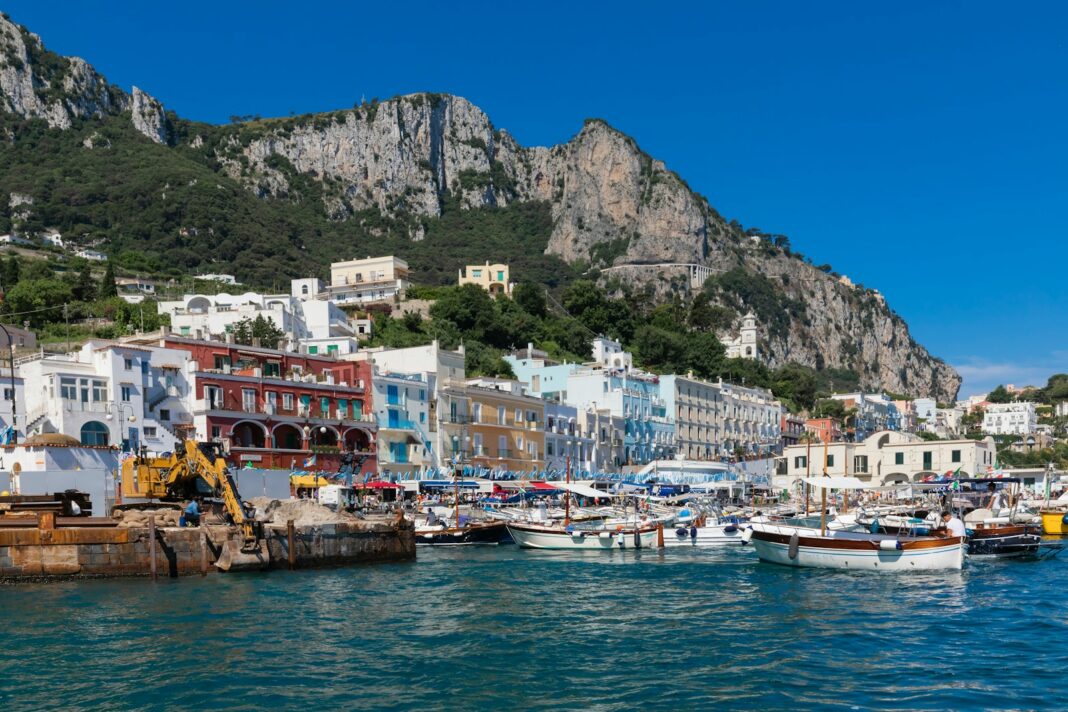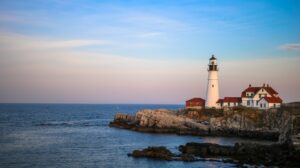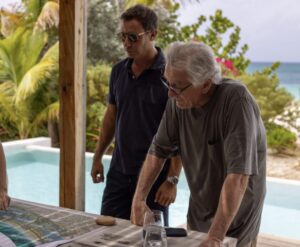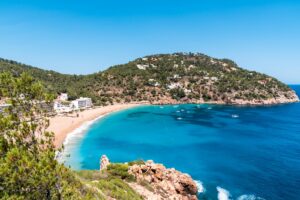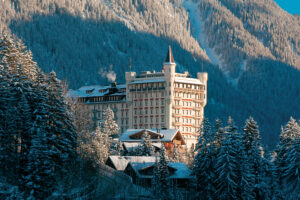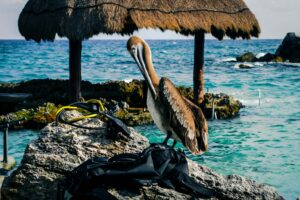Capri, Italy, a small island in the Tyrrhenian Sea, has captivated the hearts of travelers, artists, and dreamers for centuries. Located just off the coast of the bustling city of Naples, Capri is a place where natural beauty, rich history, and a luxurious lifestyle come together to create a unique Mediterranean paradise. Known for its rugged cliffs, lush gardens, azure waters, and historic charm, Capri continues to be a favorite destination for those seeking both relaxation and adventure. This article will explore the various aspects that make Capri such a remarkable destination, from its natural wonders and cultural heritage to its culinary delights and role as a symbol of the Italian dolce vita.
1. Geography and Natural Beauty
Capri is located in the Bay of Naples, about 3 miles from the mainland. Though small in size (around 4 square miles), the island’s natural beauty is vast and diverse. Capri is divided into two main towns: Capri Town and Anacapri, each offering distinct landscapes and experiences.
1.1 The Blue Grotto (Grotta Azzurra)
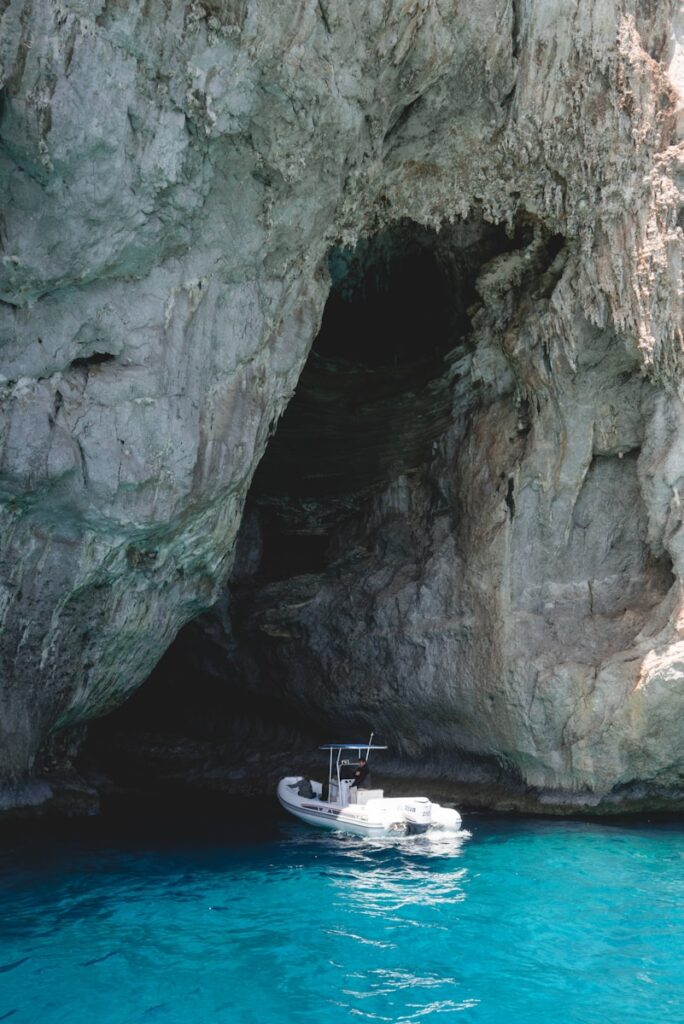
One of Capri’s most famous natural attractions is the Blue Grotto, a sea cave known for its mesmerizing blue waters. The grotto gets its ethereal glow from sunlight passing through an underwater cavity, casting a magical blue light across the interior. Visitors enter the grotto on small rowboats, as the entrance is only a few feet high, requiring the boats to glide through during low tide. The Blue Grotto has been an iconic symbol of Capri’s beauty for centuries, drawing tourists, artists, and poets alike. Roman emperors, including Tiberius, were said to have bathed in its waters, believing it to be a mystical place.
1.2 Faraglioni Rocks
Another striking feature of Capri’s coastline is the Faraglioni—three towering limestone rock formations that rise dramatically from the sea. These majestic pillars have become an iconic symbol of the island and are often depicted in postcards and photographs. The rocks are named Stella, Faraglione di Mezzo, and Faraglione di Fuori, each standing between 80 to 150 meters tall. A boat trip around these formations is one of the most popular activities on the island, and passing through the arch in the Faraglione di Mezzo is considered good luck.
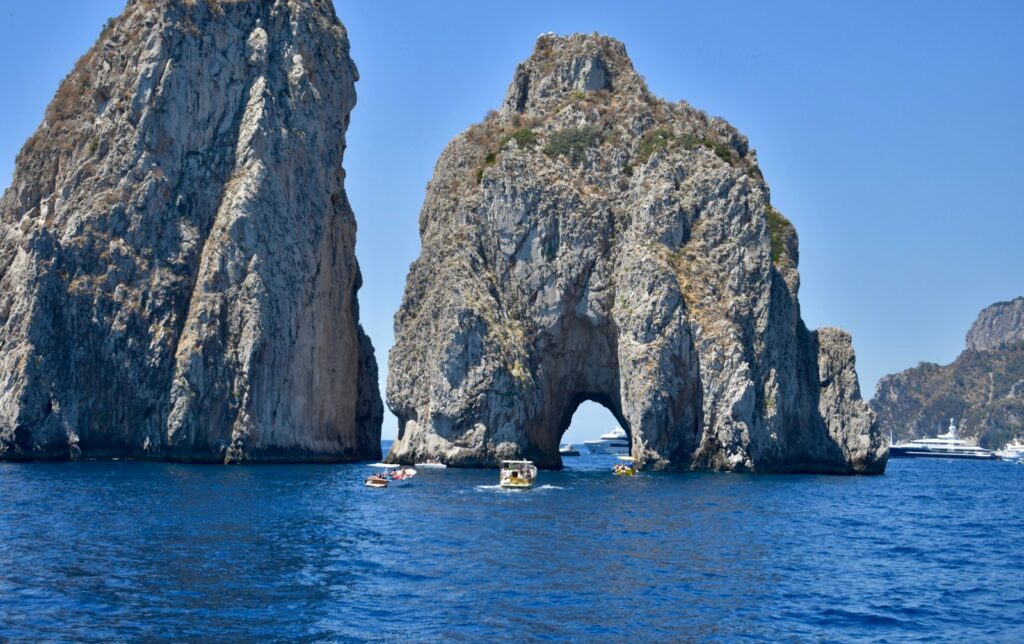
1.3 Monte Solaro
For those who enjoy hiking and panoramic views, Monte Solaro is the highest point on Capri, standing at 589 meters above sea level. From the summit, visitors are treated to breathtaking views of the Bay of Naples, the Sorrentine Peninsula, and the distant silhouette of Mount Vesuvius. The mountain can be reached by foot or by a scenic chairlift from Anacapri. At the top, there is a café where visitors can relax and enjoy the view. Monte Solaro is also known for its rich vegetation, including wildflowers, ferns, and native Mediterranean flora.
1.4 Gardens of Augustus
The Gardens of Augustus (Giardini di Augusto) are a testament to the island’s blend of natural beauty and human artistry. These beautifully manicured gardens, located near Capri Town, offer stunning views of the Faraglioni rocks and the sweeping coastline. The gardens are a serene place to stroll among vibrant flowers, shrubs, and statues. From the terraces, visitors can also look down onto the famous Via Krupp, a winding, zigzagging pathway carved into the cliffs that leads to the sea. Built in the early 20th century by the German industrialist Friedrich Alfred Krupp, the pathway is an engineering marvel that complements the natural landscape.
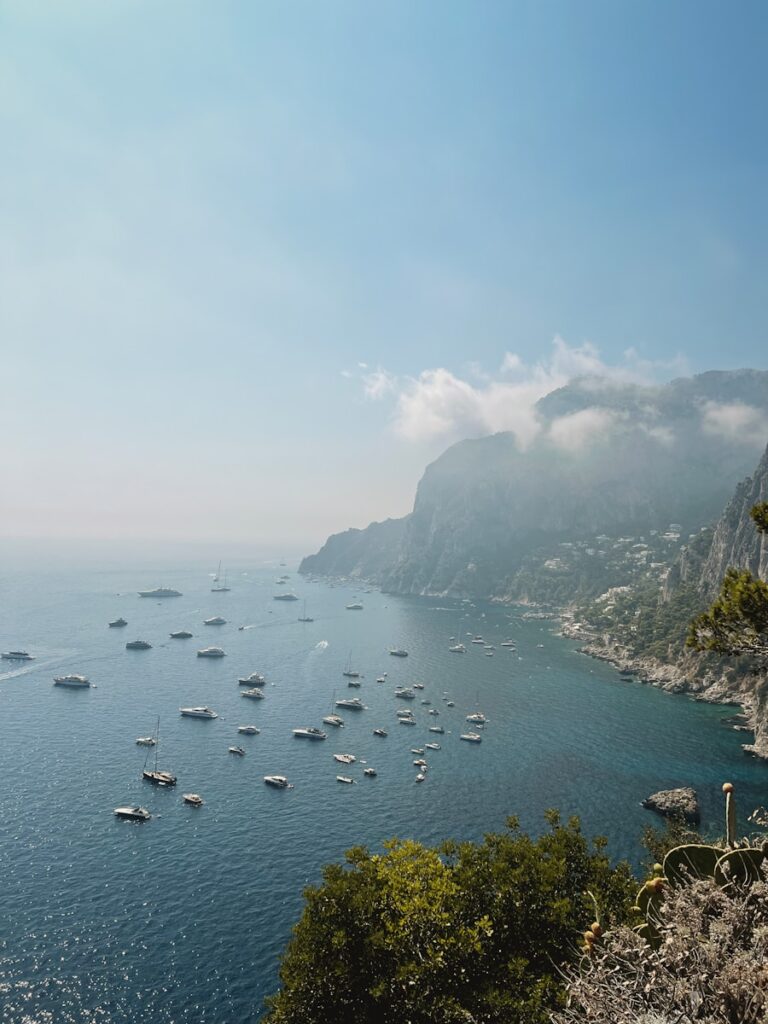
2. A History of Power and Influence
While today Capri is known as a luxury destination, its history stretches back thousands of years, and the island has played a significant role in various civilizations.
2.1 Ancient Roman Influence
Capri’s strategic location made it a prized possession for various powers throughout history, but it was during the Roman Empire that the island gained particular prominence. Emperor Augustus was one of the first Roman emperors to fall in love with the island. In 29 BC, he made Capri his private retreat, exchanging the island of Ischia with Naples to acquire it. He transformed the island into an imperial paradise, building villas and gardens and introducing exotic plants.
However, it was Emperor Tiberius, Augustus’ successor, who truly left a lasting mark on Capri. Tiberius retired to Capri in AD 27, where he ruled the Roman Empire from a distance for the last decade of his reign. Tiberius is said to have built 12 grand villas across the island, each dedicated to a different Roman god. The most famous of these villas is Villa Jovis, perched on a cliff at the eastern end of the island. Villa Jovis was a sprawling complex of rooms, baths, and gardens, and it served as Tiberius’ main residence. Today, the ruins of Villa Jovis are a major archaeological site, offering a glimpse into the luxurious lifestyle of ancient Roman emperors.

2.2 Medieval and Renaissance Capri
Following the fall of the Roman Empire, Capri saw periods of relative obscurity but was often caught in the crosshairs of foreign powers. During the Middle Ages, the island was frequently attacked by pirates and invaders. It wasn’t until the Renaissance that Capri began to regain its cultural significance. By the 14th century, the island was part of the Kingdom of Naples, and its strategic importance was recognized once again. Nobles from Naples and surrounding regions began to build summer homes on the island, seeking its tranquility and natural beauty.
2.3 19th Century Capri: The Birth of Tourism
Capri’s reputation as a tourist destination began to take shape in the 19th century. During this time, the island became popular with European aristocrats, writers, and artists, who were drawn to its picturesque landscape and mild climate. It was during this period that the island’s beauty began to be romanticized in literature and art. The rise of Romanticismin Europe, which celebrated nature and the sublime, made Capri a perfect setting for artistic inspiration.
One of the most famous figures to visit Capri during this time was the Swedish physician and writer Axel Munthe, who built Villa San Michele in Anacapri. Munthe’s villa, with its panoramic views of the Bay of Naples, became a center for intellectual and cultural gatherings. Today, Villa San Michele is a museum, open to visitors who want to experience Munthe’s vision of paradise.
3. The Island Today: Modern Capri
In the 20th century, Capri became synonymous with glamour and luxury, attracting celebrities, politicians, and the international jet set. Today, the island continues to be a playground for the wealthy, but it also remains accessible to travelers seeking natural beauty, history, and culture.
3.1 Capri Town and Anacapri
The island’s two main towns, Capri Town and Anacapri, each offer distinct experiences. Capri Town is known for its luxury boutiques, high-end restaurants, and vibrant nightlife. The Piazza Umberto I, also known as the Piazzetta, is the social heart of the island. This small square is always bustling with locals and tourists enjoying coffee, cocktails, or people-watching. Surrounding the Piazzetta are narrow streets lined with designer stores, art galleries, and quaint shops selling artisanal goods.
Anacapri, located on the higher part of the island, offers a more laid-back and authentic experience. The town is less crowded than Capri Town, and its streets are dotted with traditional houses, local eateries, and artisan workshops. Visitors to Anacapri can explore the Church of San Michele Arcangelo, famous for its intricate floor mosaic depicting the expulsion of Adam and Eve from the Garden of Eden. Anacapri is also home to Villa San Michele, Axel Munthe’s historic villa and garden, which remains one of the island’s most visited landmarks.

3.2 Luxury and Fashion
Capri’s reputation as a luxury destination is closely tied to its association with fashion and high society. The island has long been a favorite retreat for celebrities, from Jacqueline Kennedy Onassis to Sophia Loren and Grace Kelly. Today, it continues to attract stars, influencers, and business moguls seeking a slice of the dolce vita.
Capri’s fashion scene is known for its elegant, Mediterranean-inspired style. The island is famous for its Capri sandals, handmade leather shoes that have been worn by everyone from Jackie O to modern-day fashionistas. Many local artisans continue to create bespoke sandals for visitors. In addition to footwear, Capri is known for its luxury boutiques, which sell high-end Italian brands and exclusive, island-inspired designs.
3.3 The Capri Lifestyle
Capri’s lifestyle is synonymous with leisure, elegance, and indulgence. Visitors come to the island not only to see the sights but to experience the slower pace of life that defines Mediterranean living. From sipping limoncello (a local lemon liqueur) on a sun-drenched terrace to dining on fresh seafood at a seaside trattoria, the island offers countless ways to relax and enjoy life.
Dining is a highlight of any visit to Capri, and the island boasts a wealth of restaurants serving both traditional Italian fare and contemporary cuisine. Capri is particularly known for its ravioli capresi, a local dish made with fresh ricotta cheese and tomato sauce, as well as its abundant seafood. The island’s location in the Bay of Naples also means that it is a great place to enjoy pizza, another local specialty.
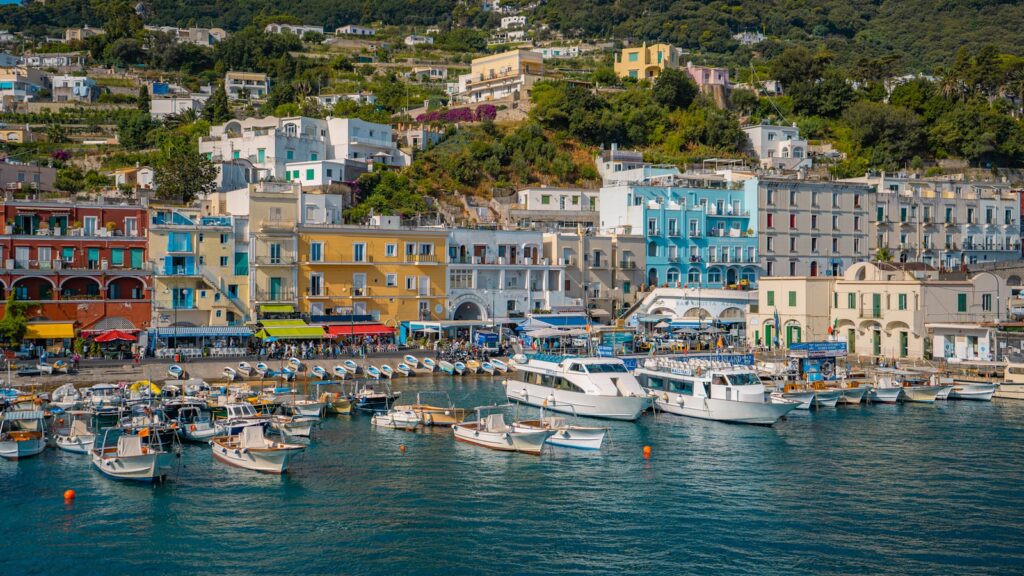
3.4 Beaches and Swimming
Though Capri is more famous for its cliffs and views than its beaches, the island does offer several spots for sunbathing and swimming in the Mediterranean’s crystal-clear waters. Marina Piccola, located on the southern side of the island, is one of the most popular beach areas. Sheltered by steep cliffs, the beach offers calm waters and views of the Faraglioni rocks. Bagni di Tiberio, near the Marina Grande, is another popular spot, with Roman ruins nearby adding to its allure.
For those looking for a more exclusive beach experience, several private beach clubs around the island offer sun loungers, umbrellas, and restaurant service. These clubs are perfect for spending a luxurious day by the water.
4. Cultural Legacy and Festivals
Capri’s cultural legacy is as rich and diverse as its natural beauty. Throughout the year, the island hosts a variety of cultural events, from art exhibitions and literary festivals to traditional religious processions.
4.1 Capri Hollywood Film Festival
One of the most notable events on the island’s cultural calendar is the Capri Hollywood Film Festival, held each year in December. The festival attracts international filmmakers, actors, and industry professionals to the island for a celebration of cinema. The event showcases a mix of Italian and international films, with a particular focus on bridging the gap between Hollywood and Italian cinema. The festival also includes workshops, panel discussions, and awards ceremonies, making it a must-attend event for film enthusiasts.
4.2 Settembrata Anacaprese
In contrast to the glamour of the film festival, the Settembrata Anacaprese is a traditional festival held in Anacapri each September. The festival celebrates local culture, food, and crafts, with street performances, music, and artisanal markets. Visitors can sample local dishes, watch folk dances, and immerse themselves in the island’s vibrant community spirit.
5. Preservation and Environmental Sustainability
Despite its popularity as a tourist destination, Capri has taken steps to preserve its natural beauty and promote sustainability. The island has limited space for development, and much of its land is protected, ensuring that its cliffs, forests, and beaches remain unspoiled. In recent years, there has been a growing emphasis on sustainable tourism, with initiatives aimed at reducing plastic waste, protecting marine life, and promoting eco-friendly transportation.
One example of Capri’s commitment to sustainability is its efforts to reduce car traffic on the island. During the summer months, cars are banned from certain areas, encouraging visitors and locals to use bicycles or electric vehicles instead.
Capri, Italy, is a place where history, culture, and natural beauty intertwine to create an unforgettable destination. Whether you’re drawn to its dramatic cliffs, ancient Roman ruins, luxurious lifestyle, or serene gardens, Capri offers something for every type of traveler. Its enduring appeal lies in its ability to balance tradition with modernity, elegance with simplicity, and natural wonder with human artistry. As Capri continues to captivate visitors from around the world, its legacy as a symbol of the Italian dolce vita will undoubtedly endure for generations to come.


